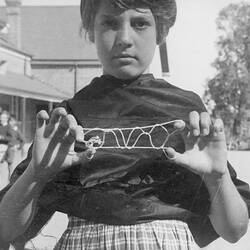Summary
Game names (and type): 'Noughts and Crosses', 'Noughts and Crosses on Chairs' (paper and pencil games)
Alternative types: team games, play with props/equipment
Handwritten description of the paper and pencil games 'Noughts and Crosses' and 'Noughts and Crosses on Chairs' composed for Dr Dorothy Howard by Glennys Brann, a twelve year old student at East Camberwell Girls Secondary School, in 1954-1955. Brann describes 'Noughts and Crosses' as a game requiring two players aged nine and above, which can be played all year in many locations. She lists some of the children she plays with including Penny Royle, Jan Moorhouse, Lyn Parker and her brother Geoff. To play, players select either 'noughts' or 'crosses', taking turns to enter these symbols into a nine square grid. Brann explains that the game's objective is to achieve a row of three, matching symbols. She provides several hand drawn diagrams illustrating different ways in which a player can win. Brann notes that if all squares have been filled and neither player has won, the game is called a 'Jack'.
Brann describes a variation of the same game called 'Noughts and Crosses on Chairs'. She writes that this version is usually played indoors at social groups such as the 'Girls Friendly Society'. Instead of drawing the nine square grid on paper, players recreate the layout using chairs to represent each square. Brann provides a detailed, annotated diagram illustrating the game's configuration and the position of the players. She writes that players form two teams and each member is allocated a number. One child assumes the role of 'caller', announcing the different numbers. The corresponding children rush to secure the best chairs for their team. To differentiate between the two teams, Brann states that one team sits on the chairs and the other stands. As with 'Noughts and Crosses', the first team to secure a row of three squares is declared the winner.
One of a collection of letters describing a children's game written to children's Folklorist Dorothy Howard between 1954 and 1955. Dr. Howard came to Australia in 1954-55 as an American Fulbright scholar to study Australian children's folklore. She travelled across Australia for 10 months collecting children's playground rhymes, games, play artefacts, etc. This letter, together with the other original fieldwork collected by Dr. Howard during this period, is preserved in the Dorothy Howard Collection manuscript files, part of the Australian Children's Folklore Collection (ACFC), Archive Series 3. The ACFC is an extensive collection documenting children's folklore and related research.
Physical Description
Handwritten game description in blue ink on paper. Comprises two sheets. First page features a letterhead printed in black ink; second page features a detailed, annotated, hand drawn diagram in blue ink on reverse and borders ruled in red ink.
More Information
-
Collection Names
Australian Children's Folklore Collection, Dorothy Howard Collection
-
Collecting Areas
-
Acquisition Information
Cultural Gifts Donation from Dr June Factor, 18 May 1999
-
Acknowledgement
Donated through the Australian Government's Cultural Gifts Program.
-
Author
Glennys Brann - East Camberwell Girls' Secondary School (College), Greater Melbourne, Victoria, Australia, 1954-1955
-
Addressed To
-
Collector
-
Organisation Named
East Camberwell Girls' Secondary School (College), Mangarra Road, East Camberwell, Greater Melbourne, Victoria, Australia
-
Classification
-
Category
-
Discipline
-
Type of item
-
Overall Dimensions
204 mm (Width), 254 mm (Height)
Orientation: portrait. Note: dimensions include first page only.
-
Keywords





